Inground vs Above-Ground Pools
Breaking down price, resell value, longevity, and more in our in-depth guide.
January 16th, 2025
January 16th, 2025

Choosing between an inground and above-ground swimming pool can be a big decision, especially if you're trying to find the best fit for your backyard, budget, and lifestyle. Each pool type has its own set of advantages, considerations, and costs, so it's worth diving into the details to understand which option works best for you.
Below, we’ll break down the key differences, pros and cons, and costs of inground and above-ground pools to help you make an informed decision.
At their core, the primary difference between inground and above-ground pools lies in their placement and construction:
While both provide the same ultimate benefit—refreshing fun and relaxation—they cater to different needs and budgets.
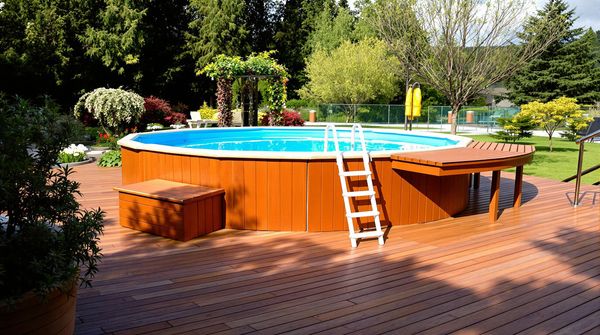
Above-ground pools are freestanding structures made from materials like steel, resin, or aluminum. They’re typically installed in a backyard without significant excavation or permanent changes to the property. Because of their affordability and ease of installation, above-ground pools are a popular choice for homeowners looking for a budget-friendly swimming option.
| Pros | Cons |
|---|---|
| Affordability: Above-ground pools cost significantly less than their inground counterparts. | Aesthetic Appeal: Above-ground pools may not blend seamlessly with landscaping and can look less polished. |
| Easy Installation: Most above-ground pools can be set up in just a few days, making them ideal for those who want a quick solution. | Limited Customization: Unlike inground pools, these offer fewer options for shape, size, and design. |
| Mobility: If you move, you can often take your above-ground pool with you. | Durability: They are less durable and have a shorter lifespan compared to inground pools. |
| Lower Maintenance Costs: Repairs and maintenance for above-ground pools are typically less expensive. | Smaller Size: Above-ground pools generally have limited depth and size options. |
Homeowners with smaller budgets.
Renters or those not ready to commit to a permanent structure.
Families looking for a temporary swimming solution.
Those with limited space or uneven terrain that would make inground installation challenging.
The cost of an above-ground pool can vary based on size, materials, and features, but most options range from $1,000 to $5,000 for basic models. Premium models with decks, fencing, and other accessories may cost more, reaching up to $15,000.
Setting up an above-ground pool involves a few straightforward steps:
Site Preparation: Clear and level the area where the pool will be installed.
Frame Assembly: Follow the manufacturer’s instructions to assemble the pool structure.
Liner Installation: Install the pool liner carefully to prevent wrinkles or leaks.
Filling and Equipment Setup: Fill the pool with water and connect any necessary filtration and pump systems.
Most setups can be completed in just a weekend with a bit of DIY effort or the help of professionals.
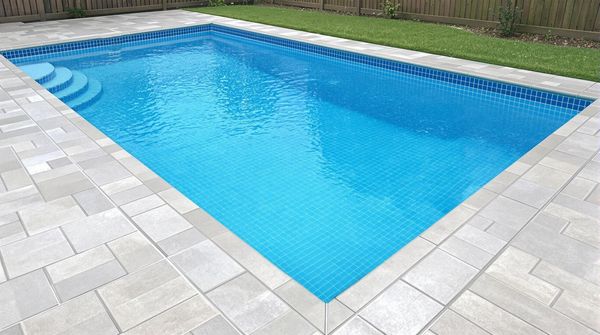
Inground pools are built directly into the ground, offering a sleek, polished look that integrates seamlessly with your outdoor space. They’re often made from materials like concrete, fiberglass, or vinyl liners and can be customized to fit your specific needs.
Read more about inground pools >
| Pros | Cons |
|---|---|
| Aesthetic Appeal: Inground pools are a centerpiece of backyard landscaping and can increase property value. | High Cost: Inground pools are a significant investment. |
| Customization: Choose from various shapes, sizes, depths, and finishes to match your preferences. | Lengthy Installation: The process can take several weeks or even months. |
| Durability: With proper care, inground pools can last for decades. | Maintenance: Regular upkeep and repairs can add up over time. |
| Size Options: Larger and deeper than above-ground pools, they’re ideal for swimming laps or diving. | Commitment: Unlike above-ground pools, they are permanent structures. |
Homeowners looking to increase their property value.
Families or individuals who want a long-term investment.
Those with large yards and a vision for a custom-designed outdoor space.
People who prioritize aesthetic appeal and functionality.
The cost of an inground pool can range from $35,000 to $100,000 or more, depending on size, materials, and additional features like heating, lighting, and waterfalls. Here’s a breakdown based on pool type:
Concrete Pools: $50,000 to $100,000 (or higher for custom designs).
Fiberglass Pools: $35,000 to $65,000.
Vinyl Liner Pools: $25,000 to $50,000.
Installing an inground pool involves several stages and often requires professional expertise:
Design and Permits: Work with a contractor to create a design and obtain necessary permits.
Excavation: Digging the pool area is the first major step.
Installation of Materials: Concrete, fiberglass, or vinyl liners are installed, along with any plumbing and electrical work.
Filling and Finishing Touches: Fill the pool with water and add landscaping or hardscaping features.
The entire process can take anywhere from 6 to 12 weeks, depending on the complexity of the project.
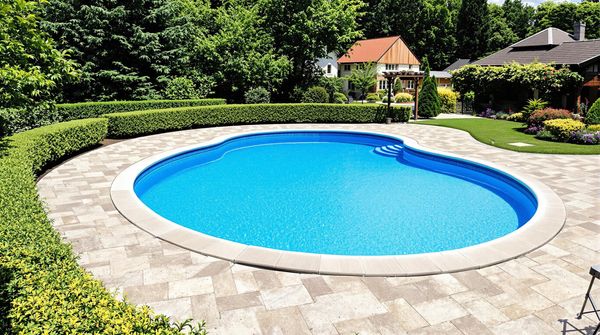
When it comes to pool design, aesthetics play a massive role in creating the perfect backyard retreat. A swimming pool isn’t just about function—it’s a visual centerpiece that can elevate your outdoor space. Both above-ground and inground pools come with their own design possibilities, but inground pools undeniably offer more flexibility and a higher-end appearance.
Above-ground pools tend to follow a more traditional route when it comes to shapes. You’ll typically find circular or oval designs, and while they serve the purpose of providing a space to swim and cool off, the lack of shape variety can feel limiting. These designs are practical but may not always blend seamlessly into your landscape.
Inground pools, however, are a different story. Whether you want a rectangular pool for laps, a freeform shape for a tropical vibe, or something geometric and modern, the possibilities are endless. Inground pools allow for creative freedom, with shapes tailored to fit your yard’s dimensions and style. This versatility also extends to adding unique features like vanishing edges, tanning ledges, or built-in seating areas.
Customization is where inground pools truly shine. You can create a pool that’s entirely your own, whether it’s a serene oasis or an entertainment hub. Options like mosaic tiles, waterfalls, LED lighting, and integrated landscaping can turn your pool into a one-of-a-kind masterpiece. Custom designs are especially popular for homeowners looking to achieve a cohesive outdoor look that enhances their property’s overall aesthetic.
Above-ground pools, on the other hand, don’t offer much room for customization beyond basic add-ons like decking or railings. While these features can make an above-ground pool more visually appealing, they rarely compare to the high-end look of an inground setup.
For those looking to enjoy year-round relaxation, adding a spa or hot tub to your pool area is a fantastic option. While above-ground pools can sometimes accommodate separate hot tub installations nearby, inground pools provide a more integrated approach. Spas can be seamlessly connected to the pool, with shared heating systems and matching finishes that blend perfectly into the design. This integration creates a luxurious experience, allowing you to transition from a refreshing swim to a warm soak effortlessly.
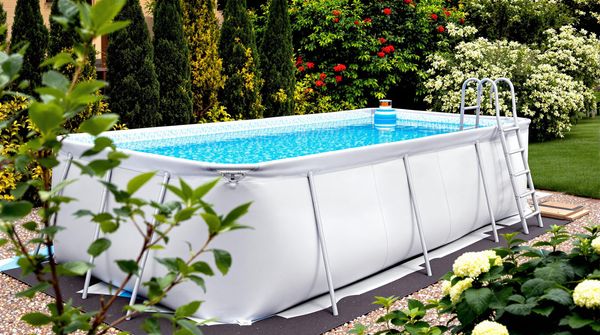
A swimming pool is a significant investment, so understanding its lifespan and durability is crucial. Both above-ground and inground pools have their strengths and weaknesses when it comes to how long they last and how well they hold up over time.
Above-ground pools are generally less durable than inground pools. Their materials, which often include steel, resin, or aluminum frames paired with vinyl liners, are designed for affordability and ease of installation rather than long-term resilience. On average, an above-ground pool will last between 7 to 15 years with proper care. However, the vinyl liners may require replacement every 5 to 9 years, depending on wear and tear.
Environmental factors like harsh winters or extreme sunlight can also shorten an above-ground pool’s lifespan. Regular maintenance—such as checking for rust, cleaning the liner, and ensuring the frame stays stable—can help extend its usability. Still, it’s worth noting that above-ground pools are generally seen as temporary solutions, especially compared to their inground counterparts.
Inground pools are built to last, often becoming a permanent fixture in your backyard. Depending on the construction materials, their lifespan can vary:
Concrete pools: These are the most durable, lasting 50 years or more with proper maintenance. However, they require resurfacing every 10 to 15 years to stay in top condition.
Fiberglass pools: With minimal upkeep, fiberglass pools can last 20 to 30 years, making them a lower-maintenance option. They resist algae growth and don’t require frequent resurfacing.
Vinyl liner pools: While the structure itself can last for decades, the liner will need to be replaced every 5 to 9 years, similar to above-ground pools.
Inground pools also stand up better to extreme weather conditions, provided they are winterized and maintained correctly. Their durability and longevity make them a solid investment for homeowners who see a pool as a long-term addition to their property.
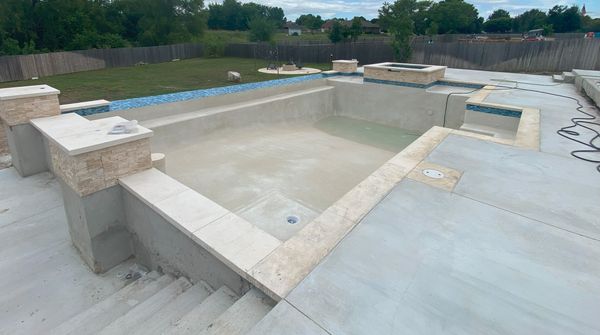
The process of installing a swimming pool varies greatly depending on whether you’re opting for an inground or above-ground model. From the time it takes to complete the installation to the complexity of the work involved, each type of pool comes with its own timeline and challenges.
Inground pools are a serious undertaking, both in terms of time and effort. The installation process can take several weeks or even months from start to finish. It begins with designing the pool, obtaining permits, and preparing the site, which often involves significant excavation. After the groundwork is complete, the pool shell—whether concrete, fiberglass, or vinyl liner—is installed, followed by plumbing, electrical work, and finishing touches like decking or landscaping.
The timeline is extended further if you choose custom features such as waterfalls, tanning ledges, or intricate tiling. While the end result is undeniably stunning, it requires patience and a willingness to deal with construction on your property.
Above-ground pools, in stark contrast, are the epitome of convenience. Most models can be set up in just a day or two, and if you’re handy with tools, it might take only a few hours. Since there’s no excavation or major construction required, the process is straightforward. Many above-ground pools come in DIY kits, allowing you to assemble the frame, install the liner, and connect the filtration system with minimal fuss.
The simplicity of installation makes above-ground pools a popular choice for renters, families on a budget, or anyone looking to enjoy a pool without committing to a long-term project.
For those who want the durability and aesthetic appeal of an inground pool but don’t want to endure a lengthy installation, pre-cast concrete or shipping container pools offer a fantastic alternative. These pools are constructed offsite and delivered to your property, dramatically reducing installation time. In some cases, they can be fully installed and ready to use within a week.
Pre-cast and container pools also blend modern design with practicality, making them a trendy and functional option for homeowners who value both speed and style.
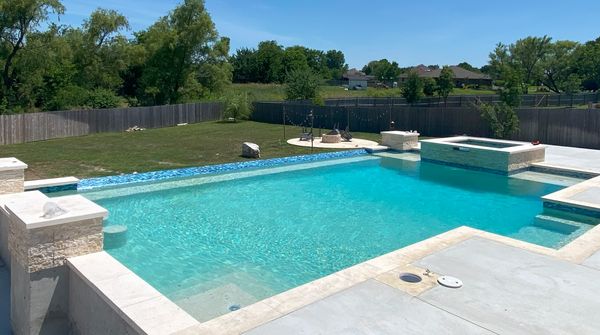
When it comes to size and depth, inground pools have a clear advantage. They can be built to virtually any dimensions, making them ideal for everything from casual swimming to diving and lap swimming. You can customize the depth, add a shallow wading area, or include a deep end for diving boards.
Above-ground pools, on the other hand, are more limited. Their standard designs typically max out at a depth of 4 to 5 feet, and their sizes are restricted by the prefabricated materials. While they’re perfect for cooling off or floating on a hot day, they may not be suitable for serious swimmers or families looking for varied depths.
A swimming pool can significantly impact your home’s resale value, but the effect varies depending on whether you have an inground or above-ground pool. Let’s explore how each type influences the value of your property.
Inground pools are often seen as a luxury feature that can boost your home’s curb appeal and overall value. However, the extent of the increase depends on several factors, including:
The quality and condition of the pool.
How well it integrates with your landscaping.
The preferences of buyers in your area.
In regions with warm climates, an inground pool can add significant value, making your home more attractive to potential buyers. On average, experts estimate that an inground pool can increase your property’s resale value by 5% to 7%. Keep in mind, though, that this also depends on your pool’s upkeep—poor maintenance can have the opposite effect.
Above-ground pools, while enjoyable, rarely contribute positively to resale value. In fact, some buyers may view them as an eyesore or an added maintenance responsibility. Unlike inground pools, above-ground models are considered temporary and don’t enhance the property in the same way.
In most cases, an above-ground pool will neither increase nor decrease your home’s value significantly, but it could impact the speed of your sale depending on how prospective buyers feel about it. If resale value is a priority, an above-ground pool might not be the best choice for your long-term plans.
Before installing a swimming pool, whether it’s an above-ground or inground model, it’s essential to understand the regulations and permits that may apply. These rules ensure that your pool is safe, compliant, and doesn’t cause any unexpected legal or neighborhood issues.
Every city or municipality has its own set of pool regulations, and these often vary depending on the type of pool you’re installing. Local laws typically cover requirements such as:
Permits: Most areas require a building permit for pool installation, especially for inground pools. This involves submitting plans to your local zoning or building department and may include inspections throughout the construction process.
Setbacks: Pools must usually be a certain distance from property lines, fences, or structures. These setback rules prevent overcrowding and ensure proper drainage.
Fencing and Safety Barriers: Many localities mandate that pools be enclosed with fences or barriers to prevent accidents, especially involving children. The fence height, gate locks, and other safety features are often specified by law.
Utility Clearance: Before any digging begins, you’ll need to verify the location of underground utilities like gas lines, water pipes, or electrical cables.
Failing to comply with local laws can result in fines, delays, or even the removal of your pool. It’s always wise to check with your local building department to ensure you’re meeting all requirements before beginning the project.
If you live in a neighborhood governed by a homeowners association (HOA), you’ll need to consider their rules and restrictions as well. HOAs often have strict guidelines about the type, size, and placement of pools to maintain the community’s aesthetic and property values.
Some common HOA rules regarding pools include:
Approval Process: You may need to submit plans and obtain approval from the HOA board before installing a pool.
Pool Type Restrictions: Some HOAs prohibit above-ground pools or limit the types of inground pools allowed.
Landscaping and Maintenance: HOAs may require specific landscaping around the pool or enforce rules about keeping the area clean and well-maintained.
Noise and Usage: Rules about pool noise levels, hours of use, or hosting large gatherings might also apply.
Failing to adhere to HOA rules can lead to penalties or conflicts with your neighbors, so it’s crucial to review the community guidelines and communicate with your HOA board before starting any pool project.
Deciding between an inground and above-ground pool ultimately comes down to your budget, lifestyle, and long-term plans. If you’re looking for an affordable, quick-to-install option, an above-ground pool might be perfect for you. On the other hand, if you want a custom-designed pool that adds value to your home, an inground pool could be the way to go.
No matter which option you choose, the goal is to create a backyard oasis that brings joy, relaxation, and endless summer memories.